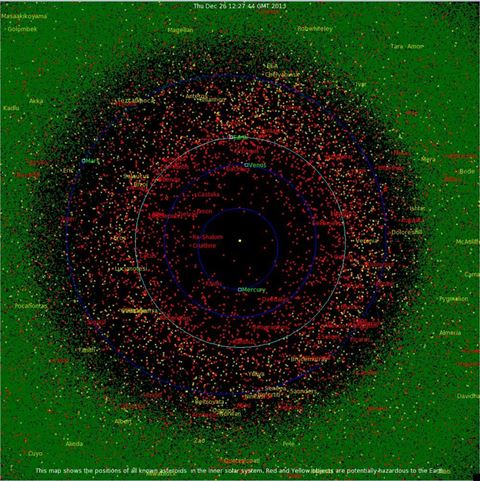
Previously, scientists believed that asteroids were static and remained near the sun. However, observations in the last decade have revealed that asteroids show up in unexpected places in space.
"That [theory] has been completely turned on its head," Francesca DeMeo, who did much of the mapping as a postdoc in MIT's Department of Earth, Atmospheric and Planetary Sciences, said in a statement. "Today we think the absolute opposite: Everything's been moved around a lot and the solar system has been very dynamic."
Researchers developed a map that charts the size, composition and location of more than 100,000 asteroids throughout the solar system. The new maps suggests the early solar system could have undergone dramatic changes before the planets laid claim to their current alignment.
Some scientists believe Jupiter may have drifted close to the sun, dragging asteroids along with it that originally formed in the colder edges of the solar system. This migration could have knocked around more close-in asteroids, scattering them outward.
Comment: Ooh, they're getting warm! What if it wasn't Jupiter, but something else that is still on an eccentric (and therefore 'dynamic' orbit)? Maybe it's time to revive Mueller's Nemesis theory?...
Nemesis: Does the Sun Have a 'Companion'?
"It's like Jupiter bowled a strike through the asteroid belt," DeMeo, lead author of the paper published in the journal Nature, said in a statement. "Everything that was there moves, so you have this melting pot of material coming from all over the solar system."
She said the new map will help theorists sift through these theories of how the solar system evolved early in the universe. The new map most likely includes every asteroid down to a diameter of just 3 miles.
Comment: FORGET "the early solar system", for pete's sake! It's a cycle, so there is no 'beginning'!
According to the map, the farther an asteroid gets from the sun, the colder the asteroids appear. However, small asteroids can be found close to the sun and throughout the solar system. Asteroids that resemble colder bodies beyond Jupiter can also be found in the inner asteroid belt, closer to Mars.
The team said that the trickle of asteroids discovered in unexpected locations has turned into a river. They said that all asteroid types exist in every region of the main belt.
"What they have done is attempted to at least qualitatively describe how the unexpected relationships between asteroid size, distance from the sun, and composition fit into the current dynamical models and other insights from the past two decades," Clark Chapman, a senior research scientist at the Southwest Research Institute in Boulder, Colorado, said in a statement. "I'm very glad that this basic research has been done, and I think it is a most welcome contribution to understanding the solar system."
DeMeo says early pinballing of asteroids around the solar system could have had a big impact on Earth. Colder asteroids that formed farther out likely contained ice, so when they were brought closer in they may have collided with Earth and left remnants of ice that eventually melted into water.
"The story of what the asteroid belt is telling us also relates to how Earth developed water, and how it stayed in this Goldilocks region of habitability today," DeMeo says.



yet-to-be-discovered Twin Sun
[Link]
cyclical electrical double star interaction
[Link]
stellar evolution
[Link]